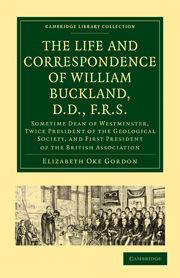 The Life and Correspondence of William Buckland, D.D., F.R.S.
The Life and Correspondence of William Buckland, D.D., F.R.S. CHAPTER III
Published online by Cambridge University Press: 05 November 2011
Summary
In 1822 Dr. Buckland addressed to the Royal Society, of which he had been elected Fellow in 1818, a paper describing his researches in the bone cave of Kirkdale, which had been discovered in the preceding year in the Vale of Pickering, about twenty-five miles from York, and was the first fossil cave known in England. This paper was printed in the Philosophical Transactions for 1822, and made so considerable an impression that its author was, in the same year, honoured with the Copley Medal of the Royal Society.
In 1823 Dr. Buckland published in a quarto volume his “Reliquiæ Diluvianæ.” This important work made his name still more widely known. To its value and influence Professor Boyd Dawkins of Owens College, Manchester, bears warm testimony:—
“I give you the impression of one who as an undergraduate fell under the influence of Dr. Buckland's name handed down by tradition at Oxford, and who afterwards, as a teacher, has had some experience of the value of his work. When I went up to Oxford in 1857, Dr. Buckland's name was a great memory in the University, and Professor Phillips, who had worked with him side by side almost from the beginning of his geological work, was giving lectures in the Old Clarendon Buildings facing the Broad. The parts of these lectures which left a lasting mark on me were those relating to the liassic reptiles, and the Reptiles and Mammalia from Stonesfield, both of which had been either discovered, or specially dealt with, by Dr. Buckland in the Bridgewater Treatise, and were in his collection. […]
- Type
- Chapter
- Information
- The Life and Correspondence of William Buckland, D.D., F.R.S.Sometime Dean of Westminster, Twice President of the Geological Society, and First President of the British Association, pp. 55 - 86Publisher: Cambridge University PressPrint publication year: 2010First published in: 1894
